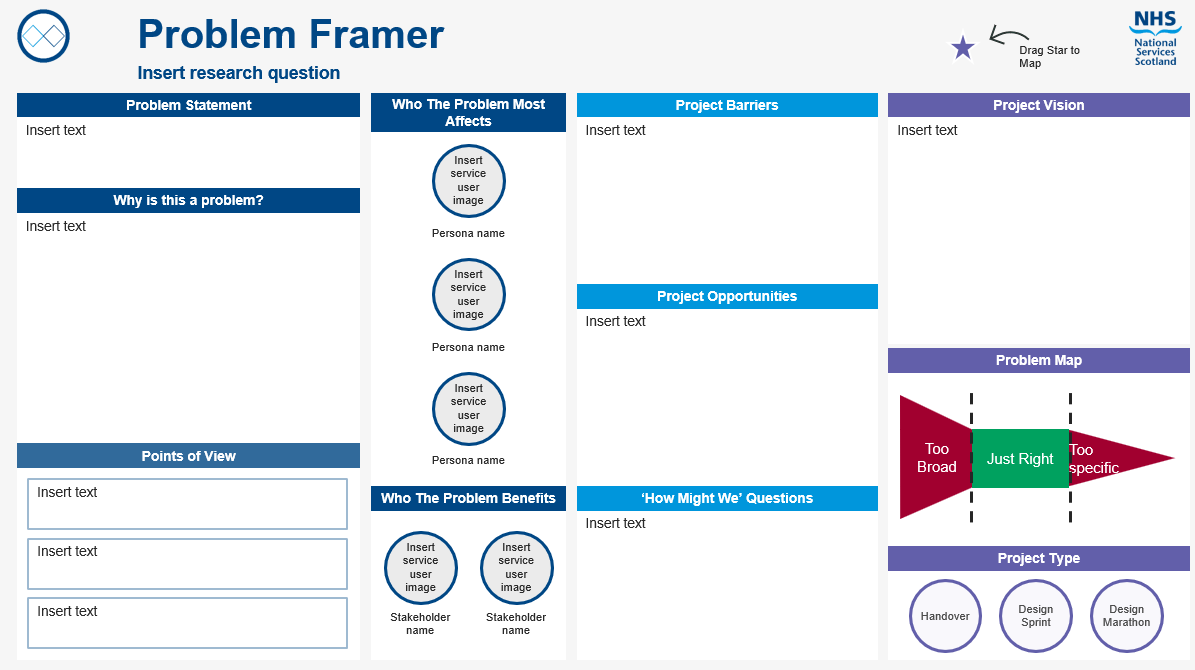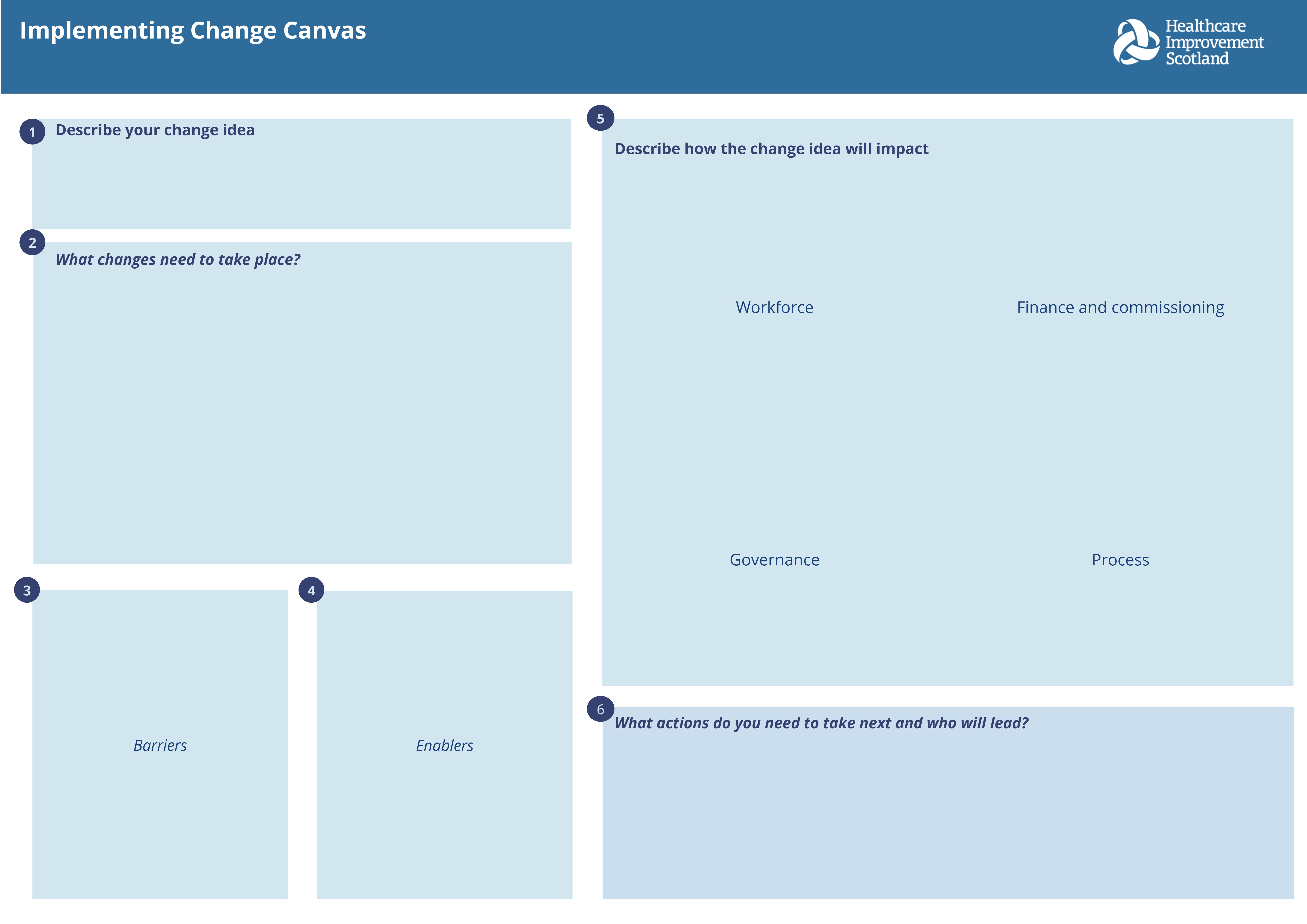The Problem Framer is a tool that helps teams think both holistically and clearly about the issue at hand, focusing on solving the right problem. It guides teams through key questions to define the problem and uncover its root cause by stepping back and seeing the bigger picture.
What is a problem framer tool?
The Problem Framer tool helps teams identify the right problem to solve, making sure solutions tackle the core issue. It focuses on exploring the what, who, and why of a problem to guide design or improvement efforts in the right direction. By framing the problem clearly, teams can align on what they are trying to solve – and why it matters – before moving on to ideas and solutions. In short, it shifts the mindset from quick fixes to truly understanding what needs to change.
When to use the problem framer tool?
Use the problem framer before starting a project or implementing a change, once you have gathered initial research, user insights, or service data. It is best applied at the end of the first diamond in the Double Diamond process, after exploring the problem space and before defining the focus. The tool is especially helpful when the problem is unclear, complex, or when stakeholders have different views about the issue.
How to use the problem framer tool?
Problem framing is best done collaboratively, often in a workshop setting or withing teams. The tool is adaptable, and teams should focus on the most relevant questions for their project.
Teams can complete it together using sticky notes or digital tools. Its clear, structured format helps make sure no important details are missed.
Problem Statement
Briefly introduce the problem.
Why Is This A Problem?
Explain the context by referring to key findings from research. Highlight insights that reveal root needs or behaviours that helped you define the problem. Consider aspects such as: environment, economy and efficiency, policies and systems, challenges and uncertainties, motivations and behaviours.
Tip: Link the problem back to the project’s relevance and the broader service or system.
Points Of View
Frame the problem from different perspectives to build a full, 360-degree view.
Teams should highlight up to three main points of view.
Example (career progression issue):
- Senior employees want to mentor junior staff but lack time or resources.
- Clients fear losing trusted relationships with retiring employees.
- Junior employees feel overwhelmed moving into senior roles due to limited guidance.
Note: If previous user stories are still relevant, feel free to bring them into this section.
Who The Problem Most Affects
Place a persona image in the circle and label it.
Identify who is most affected, remembering that designing a solution for one key group often benefits others too. E.g. Improved well-being support for doctors and nurses leads to better patient care and benefits their families as well.
Who The Problem Benefits
Some stakeholders may benefit from the problem remaining unsolved.
Identify them to better understand their influence and plan how to engage or address them.
Example: In student debt repayment challenges, financial institutions that profit from the current system are key stakeholders.
Project Barriers
List any obstacles to solving the problem, such as:
- Stakeholder behaviours and resistance
- Limited resources (time, budget, materials)
- Competition from other services
Project Opportunities
Identify opportunities for future work. Consider:
- What activities could your solution support? (e.g., a buddy system or user-centred induction process)
- Which touchpoints in the service journey could be redesigned?
- Which stakeholders should be involved in the next service design phase?
- Who should you invite to co-design sessions?
- How can you encourage experimentation and creative thinking?
How Might We Questions
Finish by writing a few "How Might We" questions to move from defining the problem to exploring solutions.
The previous user-centred how might we questions can inspire this new set of how might we questions to ensure it is rooted in user needs and aspirations.
Project Vision
Think about the following questions and choose the ones most relevant to your project:
- What will the service look or feel like once the problem is solved? How might this differ from different points of view?
- What immediate and wider impacts could the solution have?
- How will you know when the problem has been solved?
- How will you measure the effectiveness of the solution?
Problem Map
Move the star in the top right-hand corner to the Problem Map to help identify the right problem statement for your project. Check whether your statement is too broad, too specific, or just right.
A well-framed problem — one that is ‘just right’ — helps you optimise resources, time, and the quality of your outputs. For example, if your problem statement feels too specific, ask ‘why’. Is there a problem behind the problem you have identified?
Project Type
Choose the project type that best fits your problem statement. Delete the options that don’t apply:
- Hand-over Project:
If the problem is well-defined and straightforward, the team can explore solutions and hand the project over to the delivery team for implementation. - Design Sprint:
For more complex problems, a design sprint may be needed — quickly investigating, prototyping, and testing ideas across a few workshops, then handing over clear next steps. - Design Marathon:
For complex, high-risk problems, a longer, more detailed approach is needed. This involves thorough prototyping, testing, measuring, and refining over multiple phases.
More templates from the Design Community

Source: NHS National Services Scotland
Download NSS templateWhat happens after Problem Framing?
Once the team is clear on the problem and has some initial solution or change ideas, the next step is to explore whether those ideas are feasible and appropriate for the project context.
Use the Implementation Canvas to explore change ideas or proposed solutions and how they will be implemented. It can help teams brainstorm how an idea might work in practice.
This process reduces risk and provides greater clarity around potential challenges, as well as how the change may impact the people and organisations involved.
 Download HIS template
Download HIS template
